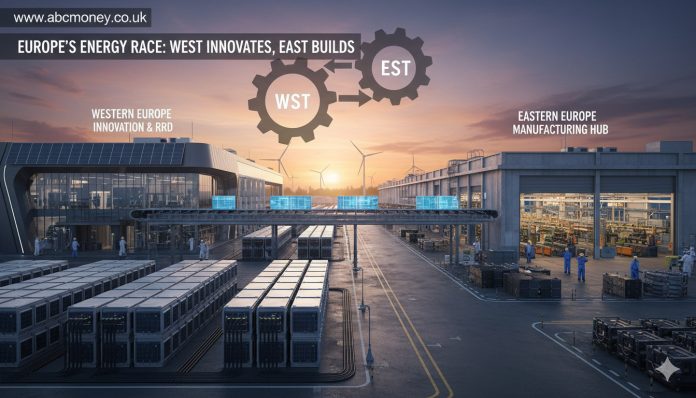Europe’s rapid build-out of wind and solar has created a new centre of gravity for the energy transition: storage. As variable generation scales, grids need flexible capacity to smooth peaks and troughs, keep systems stable and deliver clean power when it’s needed. Batteries—once a pilot-project curiosity—are now central to European planning, from home systems to utility-scale units paired with solar parks.
Policy has followed. Brussels’ climate framework couples renewables expansion with measures to accelerate storage, while national strategies weave batteries into capacity markets, grid codes and resilience plans. The message is clear: generation alone won’t deliver decarbonisation; storage must grow alongside it.
Amid this shift, the industrial footprint is changing. Western Europe still leads in research, systems integration and high-end engineering. But Central and Eastern Europe (CEE) is emerging as a manufacturing hub—helped by competitive costs, proximity to EU markets and a strong base in metalworking, electronics and automotive supply chains. Gigafactory headlines dominate, yet an equally important move is happening in the supporting hardware that makes storage work in the field.
That layer matters. Beyond cells and power electronics, storage relies on engineered components—mounting systems, switchgear cabinets, thermal solutions and, crucially, metal enclosures that protect battery packs and auxiliary equipment. These enclosures must balance mechanical strength, ingress protection, electrical safety, thermal performance and service access, while meeting project-specific requirements and delivery schedules.
Here the East’s advantages are pronounced. Many CEE manufacturers have invested in fibre-laser cutting, automated bending, robotic welding and modern powder-coating. Combined with shorter logistics into core EU markets, that toolkit enables faster design iteration, small-batch flexibility and predictable lead times—attributes prized by EPCs and integrators under deadline pressure. And the economics go beyond unit price: fewer fit-up issues on site and lower rework can make Eastern suppliers competitive on total installed cost, opening niches such as battery enclosures.
For example, one Romanian metal-fabrication company identified the emerging need for battery casings and has begun producing specialized metal enclosures for battery packs, leveraging its fabrication experience to deliver reliable products at lower cost. According to the company’s own materials, its new line of battery enclosures (and even some assembled battery units) are manufactured in Romania as part of the country’s growing clean-tech sector
Zooming out, the picture across Europe is one of complementary strengths. Western markets—Germany, France, the Nordics—are further along in integrating storage into grid services and co-located renewables, supported by established developers and financiers. Eastern members are scaling fast from a later base, encouraged by modernisation programmes, EU funds and corporate procurement. The result is a more geographically distributed value chain: cells and packs from large facilities; power electronics from established OEMs; and a widening ecosystem of specialist suppliers—many in the East—delivering cabinets, enclosures and other essential assemblies.
There are differences in documentation and delivery culture, too. Western integrators typically expect granular traceability, rigorous revision control and harmonised EN/ISO practices across documentation sets. Eastern suppliers that win repeat business tend to be those who mirror these expectations: CAD/CAM integration from cutting to bending, weld procedure consistency, controlled coating systems, and clear packing specifications to minimise transport damage. As those capabilities standardise across the region, the perceived gap between East and West narrows.
Competition is intensifying. Established Western fabricators retain advantages in complex bespoke systems, certification pathways and long supplier relationships. Eastern manufacturers, meanwhile, can undercut on simpler but critical items—like battery cabinets and BMS housings—without compromising on protection ratings or durability. For buyers, the calculus is shifting from “cheapest per unit” to “fastest path to energisation with reliable quality”, where time-to-site, design responsiveness and documentation discipline carry real weight.
What comes next? Several trends look durable:
- Regionalisation of supply chains. Expect more sourcing within the EU to reduce exposure to long logistics tails and policy risk, with CEE playing a larger role in balance-of-system hardware.
- Standardised, modular designs. As storage scales, integrators will converge on enclosure families with configurable bays, thermal options and cable management—accelerating procurement and installation.
- Broader technology mix. Lithium-ion will dominate near-term growth, but thermal management and safety features in enclosures will adapt as chemistries diversify and as codes evolve.
If Europe’s first phase of the energy transition was about gigawatts of new renewable generation, the next is about making that generation dependable. Storage is the linchpin—and the companies that craft the “quiet hardware” around batteries are becoming central to the story. As Western engineering prowess meets Eastern manufacturing agility, a more resilient and competitive European supply chain is taking shape.



 Bitcoin
Bitcoin  Ethereum
Ethereum  Tether
Tether  XRP
XRP  USDC
USDC  TRON
TRON  Lido Staked Ether
Lido Staked Ether  Cardano
Cardano  Avalanche
Avalanche  Toncoin
Toncoin  Wrapped SOL
Wrapped SOL